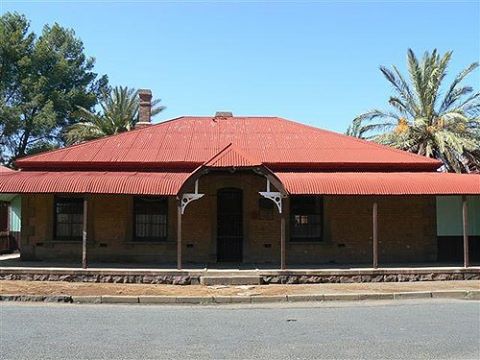Today in Kimberley's History
|
|
|
|
.
De Beers Mining Company has AGM at the new offices in Warren Street, Kimberley - 1887
The Chairman of the De Beers Mining Company, Cecil Rhodes, in his report to the shareholders at the Annual General meeting held on 6 May of 1887, said that “your Directors have found it necessary to build new offices in order to provide for the increased and increasing requirements of the company…” The Diamond Fields Advertiser reporter, skilled in shorthand, wrote: “Yesterday afternoon the Annual General Meeting of shareholders in the above company was held in the new offices, where there was present Messrs CJ Rhodes, MLA, in the Chair…” This suggests that construction of what is known as the Rhodes’ Boardroom began at some stage during 1886 and was completed in early 1887, nearly a full year before the amalgamation of the Kimberley mines. The new Boardroom was built using are what is known as “Church and McLauchlin” bricks and the process used to compress the bricks before baking can be seen quite clearly upon closer inspection.
There is an interesting tale of an Illegal Diamond Buying “sting” operation that took place while building the Boardroom. There was an attempt to trap one of the bricklayers busy on the building who was suspected of this practice of IDB. Irvine Rowell Grimmer, great cricketer and golfer, and a lifelong employee of De Beers Consolidated Mines, remembered it well: “It appears that Detective Chadwick sat watching the man from an office in the old building on the opposite side of the road. The transaction was just about to be completed when Mr Roper, chief of the Diamond Detective Department, came into view on his horse, quite unconscious of what was going on. The would-be illicit diamond buyer, recognizing the passer-by, threw the diamond over the new building and it was never found. The trap had failed, so there was no case for trial.”
The Chairman of the De Beers Mining Company, Cecil Rhodes, in his report to the shareholders at the Annual General meeting held on 6 May of 1887, said that “your Directors have found it necessary to build new offices in order to provide for the increased and increasing requirements of the company…” The Diamond Fields Advertiser reporter, skilled in shorthand, wrote: “Yesterday afternoon the Annual General Meeting of shareholders in the above company was held in the new offices, where there was present Messrs CJ Rhodes, MLA, in the Chair…” This suggests that construction of what is known as the Rhodes’ Boardroom began at some stage during 1886 and was completed in early 1887, nearly a full year before the amalgamation of the Kimberley mines. The new Boardroom was built using are what is known as “Church and McLauchlin” bricks and the process used to compress the bricks before baking can be seen quite clearly upon closer inspection.
There is an interesting tale of an Illegal Diamond Buying “sting” operation that took place while building the Boardroom. There was an attempt to trap one of the bricklayers busy on the building who was suspected of this practice of IDB. Irvine Rowell Grimmer, great cricketer and golfer, and a lifelong employee of De Beers Consolidated Mines, remembered it well: “It appears that Detective Chadwick sat watching the man from an office in the old building on the opposite side of the road. The transaction was just about to be completed when Mr Roper, chief of the Diamond Detective Department, came into view on his horse, quite unconscious of what was going on. The would-be illicit diamond buyer, recognizing the passer-by, threw the diamond over the new building and it was never found. The trap had failed, so there was no case for trial.”
Paul Kruger lays the foundation stone of the Raadsaal in Pretoria’s Church Square - 1889
Church Square, which was initially called Market Square, was home to the first church built in Pretoria, which burnt down in 1882. The square's current layout was designed by Vivian S. Rees-Poole in 1912, to imitate London's Trafalgar Square and Paris' Place de la Concorde. Church Square marks what used to be the centre of Pretoria, and what is now home to many historically significant buildings, such as the Ou Raadsaal (Council Chamber), which stands on the south western corner of Church Square. On 6 May 1889, South African President Paul Kruger laid the foundation stone of the Raadsaal, which was designed in a classical style by Sytze Wopke Wierda. The building was first used in May of 1890, and has since housed all levels of government. The building was also used as the governmental seat of the British for a short time. The building currently houses the offices of the Municipal management team, and has been declared a National Monument.
Church Square, which was initially called Market Square, was home to the first church built in Pretoria, which burnt down in 1882. The square's current layout was designed by Vivian S. Rees-Poole in 1912, to imitate London's Trafalgar Square and Paris' Place de la Concorde. Church Square marks what used to be the centre of Pretoria, and what is now home to many historically significant buildings, such as the Ou Raadsaal (Council Chamber), which stands on the south western corner of Church Square. On 6 May 1889, South African President Paul Kruger laid the foundation stone of the Raadsaal, which was designed in a classical style by Sytze Wopke Wierda. The building was first used in May of 1890, and has since housed all levels of government. The building was also used as the governmental seat of the British for a short time. The building currently houses the offices of the Municipal management team, and has been declared a National Monument.
Zulu assault at Holkrantz - 1902
In the district of Vryheid, a Zulu Chief, Sikobobo, attacked a Boer regiment after the latter had stolen their cattle, burned their kraals and driven their wives and children to Vryheid as punishment for assisting a British raiding force under Col. Bottemley. The local Boer commander, Field Cornet Jan Potgieter then sent a message to Sikobobo daring him to take back his cattle. The chief then set about doing this, and a bloodbath ensued in which 56 Boers were killed, three captured and 380 head of cattle recovered. Fifty-two of Sikobobo's men were killed. Among the underlying causes of this conflict was the fact that the Boers felt betrayed that the British had armed Black people during the South African War, though in many cases they had done the same.
In the district of Vryheid, a Zulu Chief, Sikobobo, attacked a Boer regiment after the latter had stolen their cattle, burned their kraals and driven their wives and children to Vryheid as punishment for assisting a British raiding force under Col. Bottemley. The local Boer commander, Field Cornet Jan Potgieter then sent a message to Sikobobo daring him to take back his cattle. The chief then set about doing this, and a bloodbath ensued in which 56 Boers were killed, three captured and 380 head of cattle recovered. Fifty-two of Sikobobo's men were killed. Among the underlying causes of this conflict was the fact that the Boers felt betrayed that the British had armed Black people during the South African War, though in many cases they had done the same.
P.W. Botha resigns from the National Party - 1990
Former leader of the National Party (NP) and head of state, P.W. Botha, resigned from the party in protest against President F.W. de Klerk's reform proposals. He had resigned as state president on 14 August 1989 in the midst of rising political instability, growing economic problems and diplomatic isolation.
Former leader of the National Party (NP) and head of state, P.W. Botha, resigned from the party in protest against President F.W. de Klerk's reform proposals. He had resigned as state president on 14 August 1989 in the midst of rising political instability, growing economic problems and diplomatic isolation.

